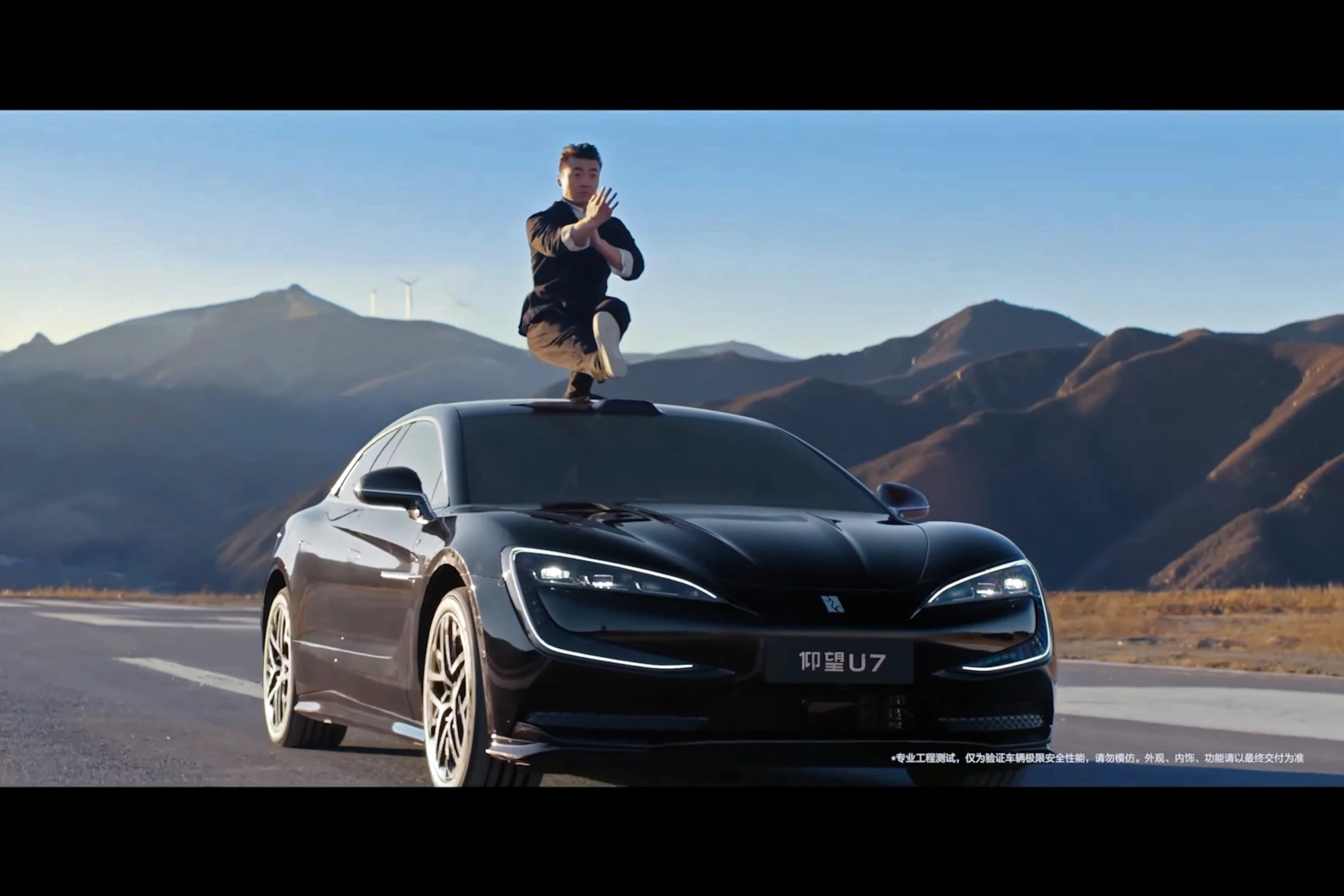Yangwang, the Chinese carmaker that brought us the [Mach 5 inspired?] jumping/dancing U9 electric hypercar, isn't shy when it comes to boasting about the off-kilter feats its vehicles can deliver. This time it's rooftop Wing Chun on the new U7.
The promotional video opens with what looks like the cast of Cirque de Soleil as they perform a variety of acrobatics from performers balancing fine China (absolutely no pun intended) in impossible poses to juggling to graceful human towers – all while atop the roof – as it drives across a random spattering of cobblestone streets and speedbumps from about 1.2 inches to 2 inches (30mm-50mm) tall, scattered about like a roadway minefield.
In a later segment, a Wing Chun master – have you ever seen Donnie Yen in Ip Man? That's what we're talking about – drops into a Tai Chi-like pose, squatting gracefully on one foot, balancing on the roof of the U7.
The point is that this Yangwang has one heckuva sweet ride.
The U7 uses an active electromagnetic suspension setup called DiSus-Z. What really sets it apart from traditional hydraulic shocks is its integration with the car's LiDAR and cameras and makes predictive adjustments to the stiffness of the shock. It literally scans the road conditions about half a second ahead to anticipate any bumps and adjust accordingly – up to 1,000 times per second. That's a lot.
In fact, it's superior to even some of the most advanced adaptive suspension systems out there, like Audi's predictive air suspension or Mercedes' E-Active Body Control.
The 17-ft 5-inch (5.3-meter), 6,825-lb (3,095-kg) monster made its hefty debut on March 27. To make up for its Ford F-250 Super Duty Crew Cab Diesel 4x4-weight (yes, it really weighs the same), it has no shortage of ponies under the hood with 1,282 hp (956 kW) and 1,168 lb-ft of torque (1,584 Nm) ready to burn through its 135.5-kWh battery pack for a CLTC-rated 447 miles (720 km) of range ... but let's be real; the China Light-Duty Vehicle Test Cycle is always overly optimistic by 15-20% when it comes to EV range. EPA standards, which are much more real-world standards, would relegate BYD's U7 dead on the side of the road in around 310–357 miles (499–575 km).
But no fear, the BYD Yangwang U7 supports 500-kW charging. Theoretically, if all the stars aligned and the moon phase was just right during the autumnal solstice, the car could be charged from completely dead to 100% in just over 16 minutes. You see what I did there, right? In reality, however, BYD says it'll do 30% to 80% in just under 20 minutes.
And by the way, those wild, wild horses aren't actually under the hood. The Yangwang U7 has four motors, one at each wheel, averaging about 320 hp (239 kW) each. That's good for a ~2.8-second 0-60 mph time (2.9-second 0-100 km/h), pitting it right there with a Lamborghini Huracán Performante – "performante" is Italian for super-duper fast.
BYD says the Yangwang U7 has a drag coefficient of 0.195, making it one slippery car; allowing it to cut through the air at speed with less battery-consuming resistance. To put that in perspective, Aptera's new dolphin-shaped EV – 20 years in the making with claims of being the most aerodynamic car ever – is 0.13 (it's essentially a road-legal UFO). On the opposite end of the spectrum, the world's worst drag coefficient is a parachute at about 1.2. Makes sense, as it's literally designed to catch air.
Similar to the Yangwang U9 hypercar, the U7 has most of the "Speed Racer Mach 5" features. It can dance gleefully and do some of the craziest autonomous torque-vectored parallel parking jobs you've ever seen. Sadly, it's not equipped to hop over spike strips – Yet.
All this and more for US$86,500 to $98,000, depending on trim level, minus tariffs and import fees (not actually sold in the US).
Check it out!
Source: Car News China




